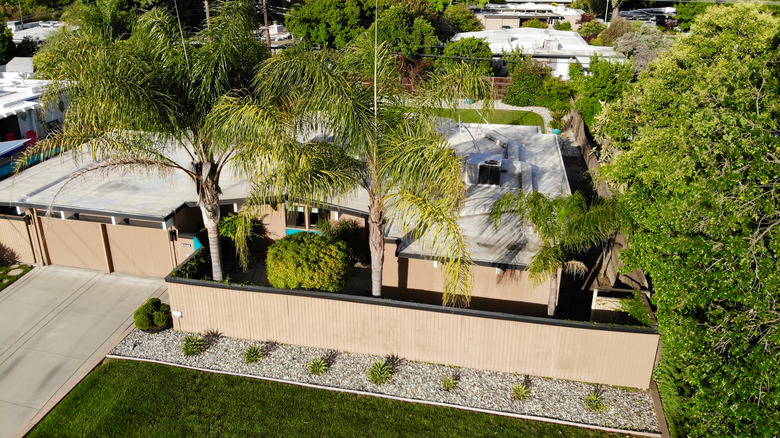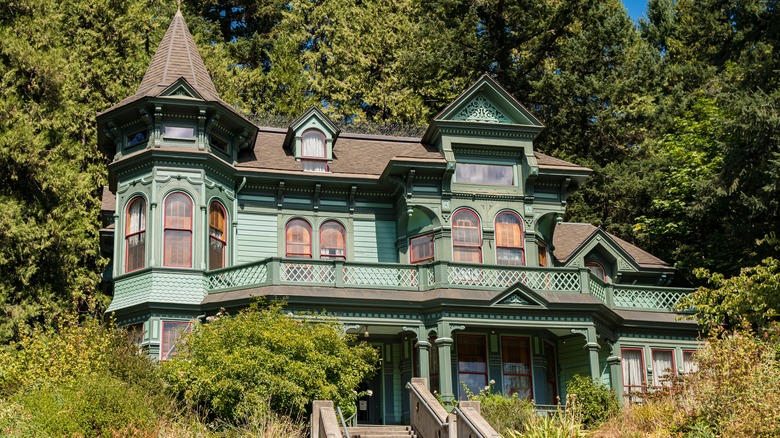What Are House Eaves And Why Are They Important For Your Home?
Eaves: While the name itself evokes something romantic and picturesque, these undersides of your roof serve a practical purpose and keep water away from the building's walls during rainstorms. The overhang produced by the eaves also keeps your home cleaner and maintains it. Furthermore, eaves can act as a sun barrier, creating more shade during the summer so your air conditioner gets a little cooling help, notes Communities. But eaves aren't only functional; they add some style to your home as well. Between the four basic types and the different materials available — from PVC to cedar wood to aluminum — to create these roof extensions, a wide variety of combinations exist, with eaves adding a distinctive aesthetic to a home (via Study.com).
The word comes from the Old English efes, which means the "edge of a roof," and was probably used as early as the mid-1500s, according to the Online Etymology Dictionary. While not all buildings contain the feature, eaves can complete a home's look as they preserves its future. Here's what you need to know about eaves.
What exactly are house eaves?
A home's eaves provide decoration and practicality; they're part of classical architecture, in which you'll often see the roof's edge hanging over the exterior wall, creating a protective awning. Many homes eschew eaves, such as those with a contemporary design, in which a more streamlined feel is emphasized. For example, often buildings with flat roofs won't include eaves (via The Spruce). Additionally, some eaves are designed especially for a home's particular design; Gambrel roofs that contain flared eaves are common on Dutch colonial homes, while Victorian homes often have eaves with wide overhangs. Eaves can finish a home's look, upping its character.
Designer John Milnes Baker calls eaves "the reduced side of roofing which forecasts past the face of the wall surface," as quoted by Décor 24 Online. Eaves usually have a soffit, the section where the roof meets the building's walls, and fascia, an area that goes around the structure that covers the roof's rafters and gives the space a polished look. Furthermore, the eaves' size correlates with your roof. A pitched one might create a thin eave, while something not as high might become more spacious. Certain eave types contribute to a home's style, such as Eichler homes that embrace broad eaves that add to the modern look sought.
Pros and cons of eaves
The major advantage of having eaves is they allow melting snow and rain to stay clear of the building's sides and foundation since the dripping water gets moved further away by the extension that the eaves provide. This can also help keep your basement dry. Additionally, The Spruce points out that eaves can provide shade, keeping your home cooler in hot weather. Eaves also tend to house security cameras and outdoor lights since the high, protected space keeps them unobtrusive.
Unfortunately, that great area can also become a sanctuary for less welcome guests like wasps, yellowjackets, birds and, even bigger animals such as squirrels. All these creatures like that warm, cozy pocket near your house to build their nests. This is why homeowners should not neglect regular maintenance. You'll want to make sure that you clean away any animal homes as soon as you notice them. You can also invest in repellants to keep the uninvited away. You can even try spraying mint essential oil underneath your eaves, which keeps mud wasps at bay and use decoy nests to deter all types of wasps from becoming a neighbor. It is also a good practice to fix anything that becomes broken, like a soffit vent, before an animal notices and moves in.
Types of eaves
Eaves contain two main parts and have four basic types. Soffits, often a solid panel, are right beneath the overhang part and provide a ventilated covering for the attic. Fascia board faces outward and provides the trim and support for the roof and gutters. These are on all eave types, whether it is:
- Exposed eaves — where the roof's rafters and bottoms can be seen
- Soffited eaves — here paneling constructs the underneath part and then connects to the eave's bottom tip with the building's side at a 90-degree angle.
- Boxed-in eaves — this is when the side of the building meets the eave at the same angle the roof is pitched, and covers the rafters.
- Abbreviated eaves — when the eaves seem almost perpendicular to the structure's side.
Certain eaves are typical to specific styles of architecture. For example, boxed-in eaves are seen frequently with Colonial architecture because they dramatize those beautiful porches. Soffited eaves, however, regularly appear on European buildings because their wideness protects well from the wet (and snowy) weather that area experiences, according to Study.com.
Why are eaves important?
Besides their decorative function, eaves keep your home protected from all the elements that can hurt it; rain, sleet, and snow all take their toll on your home. Eaves essentially preserve your home's walls, siding, and foundation by encouraging all that water to cascade away from the structure. In Quebec, for instance, a place of continual snow in the winter, steep roofs with bell-like overhangs keep all those melting flakes on the nearby lawn and not around the house's immediate perimeter. Additionally, these overhangs block the beaming summer sun and help keep your home cooler, per Treehugger.
While eaves help preserve your home, you still should remain vigilant about keeping things tidy. "If it's not maintained well, it's a place for water to collect," pointed out Dave Leff, president of Leff Construction to HGTV. "Once a year when you clean and inspect your gutters, that's the time to inspect your fascia and soffit for peeling paint and other problems. Keep everything well-painted, sealed and caulked." That gives you a good rule of thumb: When it's time to clean your gutters, check your eaves.
Famous design styles and their eaves
Sometimes eaves become an important component of design. For example, the Prairie style, which originated in Chicago sometime the 1900s, was created by a group of young architects including Frank Lloyd Wright. The style went beyond its eaves, of course, and combined the elements of the Arts and Crafts aesthetic — a look that appreciated nature and its simplicity along with precise technique — and the theories of Louis Sullivan. This style is seen in homes like Wright's Robie House, as noted by the Chicago Architecture Center.
Prairie styled buildings, according to Wright, are "married to the ground," per the Chicago Architecture Center. Reminiscent of the clean long lines of the Midwest countryside, these buildings feature flat roofs, lots of rowed windows, and broad overhanging eaves. Other home styles appreciate eaves as well; according to Polaris, many A-frame homes in the United States have eaves that almost touch the ground. These mid-20th century residences and the extreme roofing offer a modern feel. Finally, many classic Italian and Spanish luxury manors feature exquisitely adorned eaves along with its subtly pitched roofs.
Want eaves? You can install them
If reading about eaves makes you sad that your home does not have them, no worries: You can add them to your home if you like. While the construction work requires some effort and expense, the good news is it's not terribly difficult, according to SF Gate.
You'll need to remove the fascia board from your roof and exterior wall. The first big job requires you to extend the rafters to create the overhang. SF Gate recommends that this should be 2 feet or less so it's stable. New fascia will be needed next and you'll also create a soffit. Finally, you should cover the overhang with new material and fix any roofing removed during this process. This is a good time to put on a new roof, but if that cost is too high, you can always replace individual shingles — trying to match the texture/color to the old ones. Presto, you're part of the eaves club.






